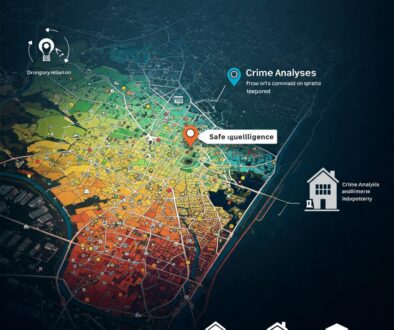Historical Data Analysis: How Past Patterns Predict Future Real Estate Success
In the complex world of real estate investment, the adage that “history repeats itself” holds surprising truth—when analyzed with sufficient sophistication. While markets evolve and circumstances change, historical patterns contain powerful predictive signals that, when properly interpreted, can significantly enhance investment decisions.
Traditional approaches to historical analysis in real estate tend to be simplistic, focusing on basic metrics like past appreciation rates or rental trends. However, modern AI-powered geospatial intelligence platforms like Locas.dev are revolutionizing how investors leverage historical data, uncovering subtle patterns and multidimensional relationships that human analysts typically miss.
The Evolution of Historical Analysis in Real Estate
Traditional Approach
Conventional historical analysis in real estate typically involves:
- Basic price trend analysis over time periods
- Simple comparable sales from past transactions
- General neighborhood historical performance
- Broad market cycle positioning
- Limited historical event impact assessment
This approach, while providing some value, suffers from significant limitations:
- Overly simplistic pattern recognition
- Limited ability to identify relevant historical parallels
- Insufficient control for multiple variables
- Inability to detect subtle leading indicators
- Tendency to overweight recent history
“Most investors look at historical data in extremely limited ways,” explains Dr. Jennifer Lee, real estate economist. “They might check what happened to prices over the last few years or how a neighborhood has generally performed. But history contains far more sophisticated patterns—transformation sequences, catalyst effects, and leading indicators—that remain invisible without advanced analytical tools.”
How AI Transforms Historical Pattern Analysis
Modern geospatial intelligence platforms transform historical analysis through:
1. Multi-Dimensional Pattern Recognition
Traditional Approach: Basic trend identification looking at single variables like price or rent over time, missing complex interrelationships between factors.
AI-Enhanced Approach: Sophisticated pattern recognition includes:
- Multivariable correlation analysis across hundreds of factors
- Temporal sequence identification of how areas transform
- Catalyst event impact modeling based on historical precedents
- Neighborhood evolution archetype matching
- Market cycle pattern recognition across multiple historical periods
Real-World Impact: “We were analyzing a transitioning industrial area with limited residential precedent,” explains Michael Chen of Meridian Development. “Traditional analysis showed minimal historical residential performance, suggesting caution. However, the AI platform identified a specific transformation pattern matching six other formerly industrial neighborhoods across the country, showing a consistent sequence of events: arts businesses arrival, followed by food and beverage, then residential conversion profitability. This pattern recognition allowed us to enter the market at the optimal moment in the transformation sequence.”
2. Predictive Sequence Mapping
Traditional Approach: Limited ability to project how current conditions will evolve based on historical precedents, often relying on simplistic assumptions about continuation of recent trends.
AI-Enhanced Approach: Detailed sequence prediction includes:
- Development sequence modeling based on historical patterns
- Evolution timeline forecasting for neighborhood changes
- Intervention point identification for optimal market entry
- Transformation acceleration/deceleration factors
- Evolution variant probability assessment
Real-World Impact: A developer evaluating an emerging neighborhood used AI-powered sequence mapping to identify not just the likely trajectory of transformation but the specific timeline of changes based on dozens of similar historical patterns. This intelligence allowed them to properly time both their acquisition and subsequent development phases, entering the market early enough to capture value creation but not so early that they faced extended carrying costs. The project achieved 43% higher returns than comparable developments that either entered too early or too late in the transformation sequence.
3. Leading Indicator Identification
Traditional Approach: Reliance on lagging indicators like recent sales or completed developments, with limited ability to spot early signals of impending changes.
AI-Enhanced Approach: Sophisticated early signal detection includes:
- Statistical anomaly detection highlighting pattern disruptions
- Early transformation signal identification
- Small-scale precursor event recognition
- Subtle demographic shift detection
- Business composition change analysis
Real-World Impact: “The AI platform identified an unusual clustering of small business license applications in a previously overlooked neighborhood,” notes Sarah Williams of Urban Investments. “Further analysis revealed this pattern had preceded significant appreciation in similar neighborhoods historically. We acquired four properties in the area before any noticeable price movement occurred. Within 18 months, values had increased 27% as the early business activity blossomed into a full neighborhood revitalization.”
4. Contextual Similarity Matching
Traditional Approach: Basic comparison to broadly similar neighborhoods or properties, often based on limited criteria like demographics or property types.
AI-Enhanced Approach: Advanced similarity intelligence includes:
- Multi-factor neighborhood matching across dozens of characteristics
- Transformation stage identification in neighborhood evolution
- Performance trajectory alignment with historical comparables
- Intervention response similarity to policy or investment changes
- Risk profile matching with historical parallels
Real-World Impact: When evaluating an opportunity in an emerging neighborhood in Charlotte, Capital Partners utilized AI-powered similarity matching to identify neighborhoods in other markets that had undergone remarkably similar transformations. Rather than just comparing current characteristics, the system matched the specific transformation stage and dozens of socioeconomic, physical, and commercial evolution patterns. This allowed them to precisely project likely appreciation rates, optimal tenant profiles, and potential challenges based on the experiences of these similar areas.
5. Catalyst Event Analysis
Traditional Approach: Limited understanding of how specific events affect real estate performance, often based on anecdotal evidence or simplified assumptions.
AI-Enhanced Approach: Comprehensive catalyst intelligence includes:
- Historical event impact quantification
- Catalyst type sensitivity analysis by property and location type
- Multi-market reaction pattern identification
- Temporal impact curve modeling showing effect distribution over time
- Combined catalyst interaction effects
Real-World Impact: “We were evaluating properties near a planned university expansion, trying to gauge the likely impact,” explains Robert Martinez of Horizon Investments. “Instead of general assumptions, our AI platform analyzed the historical effects of 37 similar university expansions nationwide, identifying specific property types and locations that had consistently benefited most. Surprisingly, certain seemingly ideal locations had historically underperformed due to factors not obvious in traditional analysis. This intelligence helped us acquire properties that outperformed the general market by 34% following the expansion.”
Case Study: The Riverside District Transformation
When Centennial Partners was evaluating investment opportunities in a transitioning urban neighborhood, they employed both traditional historical analysis and AI-powered pattern recognition:
Traditional Historical Assessment:
- Area had shown modest 3-5% annual appreciation for past 5 years
- Limited comparable development precedents in the immediate vicinity
- Some recent retail improvements noted in the area
- Neighborhood had mixed-use zoning for over a decade
- Several recent property transactions at gradually increasing prices
AI-Enhanced Historical Intelligence:
- Pattern matching identified 16 historically similar neighborhoods across the country
- Current conditions matched specific transformation stage with predictable next phases
- Early catalyst signals detected matching historical precursors to rapid appreciation
- Business license pattern showing 287% increase in specific categories correlated with transformation
- Historical timeline modeling projected acceleration point within 8-14 months
Based on this comprehensive historical intelligence, Centennial:
- Accelerated their acquisition timeline to enter before the projected market acceleration
- Adjusted their development program to align with historically successful approaches in similar areas
- Phased their project to match the projected transformation timeline
- Targeted specific tenant categories that historical patterns showed would thrive in this transformation stage
- Structured financing to optimize around the projected value increase timeline
The result was a project that entered the market at precisely the right moment in the neighborhood’s evolution, achieving returns 38% higher than projected based on simple historical trend analysis.
Key Historical Pattern Categories for Real Estate Intelligence
Modern geospatial intelligence platforms analyze several critical pattern categories to derive predictive insights:
1. Neighborhood Transformation Sequences
- Gentrification progression patterns across similar neighborhoods
- Commercial to residential conversion timelines
- Industrial area revitalization sequences
- Suburban node urbanization patterns
- Cultural district emergence trajectories
2. Market Cycle Patterns
- Phase-specific opportunity identification within market cycles
- Recession response and recovery patterns by property type
- Interest rate sensitivity historical patterns
- Capital flow migration timing during market shifts
- Distress opportunity emergence sequences
3. Policy Impact Patterns
- Zoning change implementation effects across similar jurisdictions
- Tax incentive program response patterns
- Infrastructure investment historical impacts
- Affordable housing policy effects on surrounding values
- Environmental regulation influence on development patterns
4. Demographic Shift Impacts
- Age cohort migration influence on housing demand
- Income profile evolution effects on commercial viability
- Household composition change impacts on housing types
- Education level shift correlation with neighborhood transformation
- Employment profile alteration effects on real estate demand
5. Catalyst Event Responses
- Transportation infrastructure impact curves
- Major employer relocation effect patterns
- Educational institution expansion influence
- Cultural venue development impact sequences
- Medical facility investment response patterns
Implementing Historical Pattern Intelligence in Your Investment Strategy
To leverage these powerful historical insights for your real estate investments:
1. Move Beyond Simple Historical Trends
Rather than just examining recent appreciation or rent growth:
- Identify specific transformation stage patterns in target areas
- Analyze how similar neighborhoods have evolved historically
- Look for early-stage leading indicators that precede value changes
- Understand the full sequence of catalysts and responses
- Evaluate historical pattern matching across multiple similar markets
2. Calibrate Investment Timing to Historical Patterns
One of the most powerful applications of historical pattern analysis is optimal timing:
- Identify where in established patterns your target area currently sits
- Understand historical timelines for similar transformation sequences
- Recognize catalyst points that have historically accelerated changes
- Match investment and development phases to evolutionary stages
- Time exit strategies based on historical value maximization points
3. Select Investment Targets Based on Pattern Matching
Use historical pattern recognition to identify the most promising opportunities:
- Focus on areas showing early signals of proven transformation patterns
- Identify properties with characteristics that historically outperformed during similar changes
- Target locations at specific points in established evolutionary sequences
- Look for catalyst combinations that have historically produced exceptional returns
- Avoid areas with patterns historically associated with underperformance
4. Align Development Approaches with Historical Success Patterns
Let historical analysis inform not just what and where to develop, but how:
- Match development programs to historically successful approaches in similar contexts
- Align phasing with historical transformation sequences
- Target tenant profiles that thrived in comparable historical situations
- Design amenities that historically added most value in similar settings
- Implement positioning strategies proven successful in comparable historical scenarios
5. Build Risk Mitigation Based on Historical Challenge Patterns
Use historical intelligence to anticipate and prepare for challenges:
- Identify common obstacles in similar historical transformations
- Understand timing of potential challenges based on historical patterns
- Recognize early warning signals that preceded problems in similar scenarios
- Implement mitigation strategies that historically proved effective
- Structure deals to account for historically validated risk factors
The Future of Historical Pattern Intelligence
As AI and geospatial intelligence continue to evolve, several emerging capabilities promise even more sophisticated historical pattern analysis:
Cross-Disciplinary Pattern Integration
Future systems will incorporate patterns from fields beyond real estate—such as economic cycles, social movements, and technological adoption—to create even more nuanced predictive models.
Dynamic Pattern Updating
Advanced platforms will continuously refine pattern recognition as new data emerges, creating ever more accurate predictive models that learn from ongoing market activities.
Personalized Pattern Matching
AI will increasingly identify historical patterns specifically relevant to your particular investment strategy, property types, and risk tolerance, creating customized historical intelligence.
Alternative Timeline Modeling
Future systems will model how historical patterns might have varied under different conditions, creating more robust predictive models that account for changing macroeconomic and social factors.
Real-time Pattern Recognition
Platforms will identify emerging patterns as they form, recognizing transformative sequences in their earliest stages before they’re apparent to conventional analysis.
Conclusion: From Historical Data to Strategic Intelligence
Historical patterns contain remarkably powerful predictive signals for those with the analytical tools to properly interpret them. The evolution from basic trend analysis to sophisticated pattern recognition represents a transformative opportunity for investors to:
- Identify transformation opportunities at their most advantageous stages
- Time market entries and exits with unprecedented precision
- Recognize early warning signals before they’re obvious to others
- Match development approaches to historically proven success patterns
- Anticipate and mitigate risks based on historical precedents
In an investment landscape where timing and positioning are everything, the competitive advantage increasingly belongs to those who can most effectively learn from the past to predict the future.
Ready to unlock the predictive power of historical patterns for your real estate investments? Try Locas.dev today and experience the power of AI-driven historical pattern recognition.
This article reflects the current state of AI technology in historical pattern analysis for real estate. For the latest updates and features, visit Locas.dev.
Keywords: historical real estate analysis, property investment patterns, real estate predictive patterns, neighborhood transformation sequence, real estate historical data, AI pattern recognition, investment property historical analysis



